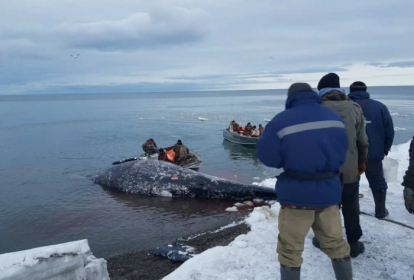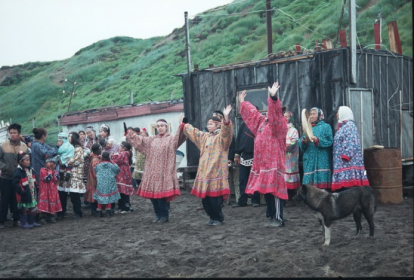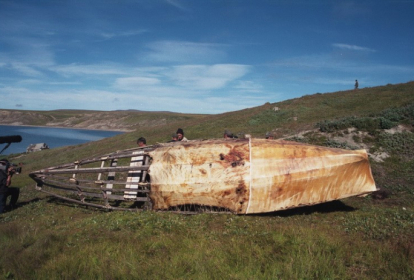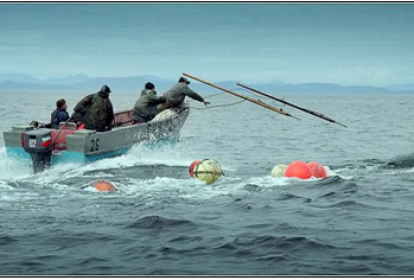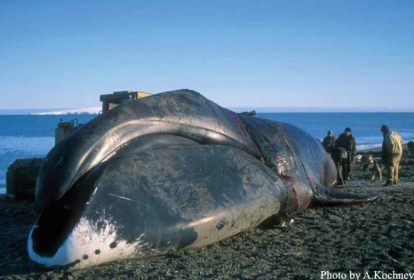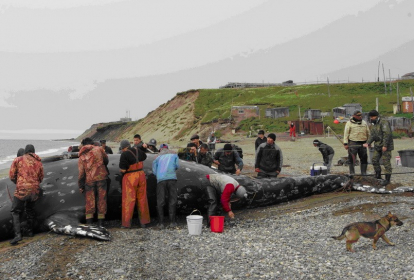1. Introduction
The Chukotka Autonomous District is the only place in the Russian Federation where traditional whaling is an activity of special importance. Chukotka is one of the most remote territories of the Russian North and conditions are extremely severe. The winter season lasts for 10 months and the average annual air temperature is -14°С in the coastal areas of the Chukotkan peninsula. Average temperatures are -28°С for February and +6°С for July. The sea surface temperature varies from +4 to +12°C in July.
At least five indigenous ethnic groups live in this region. They are primarily the Coastal and Inland Chukchi and the Bering Sea Yupik Inuit as well as the Even, the Chuvan and the Yukagir. About 15,900 Chukchi and 1,700 Inuit people were registered in 2010, including about 14,300 residents in whaling settlements. By 2015, the indigenous population had increased to over 19,000 individuals. Although up to 21 communities had historically participated in whaling (see Fig. 1), in the last 10 years only 15 have taken part in whale hunts. This is both due to lack of technical equipment but also due to the loss of whaling skills due to the rarity of the hunts during Soviet times (see below). These communities are making efforts to restore their whaling activities, through training and education and they are also asking for quota allocations.
The whale harvest not only defines the social, cultural and trading structure amongst Chukotka’s coastal villages but also plays a significant role in the traditional relationship between reindeer herding families and maritime hunters. These relations go further than the simple exchange of meat, blubber and other food. For example, the equipment used by the reindeer herding families often includes marine mammal products. Cloaks made of whale intestines are highly valued by ‘reindeer people’ because of their evaporation features, which allow man to stay dry through the day. Therefore, such exchanges have not only social/cultural/economic value but are a necessary component of survival.
Based upon historical data on consumption and the present assessment of the indigenous population of Chukotka, an annual total of 350 gray and 10 bowhead whales is reasonable to meet the needs of native people. Such needs were met in Soviet times, when commercial and logistical type vessels were used for whaling and the whales delivered to the settlements. Since that period, the amount of whale products available has halved (Fig. 2). However, while the need remains, for technical and logistical reasons, including the availability of experienced whalers, recent quota requests to date have not met the full needs of the people.
Traditional whaling is a part and parcel of existence of Chukotka’s native people, both from the point of physical survival and from the point of the cultural continuity that ultimately defines unique nature and character of the peoples of the Far North.

Fig.1. Coastal settlements of Chukotka, showing the 21 traditional whaling settlements (see text). The numbers stand for the 4 districts: 1 – Anadyrski, 2 – Iul’tinski, 3 – Providenski, 4 – Chukotski.

Estimated biomass of gray whales taken in 1969-2017
2. Recent catches for Chukotka
Chukotkan whaling is traditionally focused on two species: the gray and bowhead whales. Annual catches vary due to a number of factors, including environmental conditions, seasonal availability and the distribution of animals.
After each attempt at a strike, catch and landing, the Native community must deliver a whaling passport to the Government of Chukotka. The report includes information and specific catch data (including place, time information and environmental conditions of hunt, length, weight and sex of harvested animal, the reproductive state of females caught, hunter’s comments, the presence of traumas and injuries on the whale and details of sampling if performed).
The Chukotka Government annually sends the report to the Ministry of Natural Resources of Russian Federation, which uses the report and whaling passports to monitor the hunt and to provide the information requested by IWC.
Gray whales, Northern Feeding Group (also known as ‘eastern gray whales’)
The average annual catch over the period 2001-2017 was 124 animals (range 111-139) including 35 lost whales (average 2, range 0-9). A total of 37 whales taken during that period were “stinky” i.e. they had strong chemical smell, which made meat and blubber inedible. The reason for this phenomenon remains unclear despite investigation.
The estimated annual average gross weight of gray whales harvested in Chukotka in 2001-2017 is 1,384 tonnes. That provided an annual average of about 692 tonnes of edible products.
Catches of gray whale in coastal Chukotka waters, 2001-2017
Bering-Chukchi-Beaufort (BCB) bowhead whales
The average catch over the period 2001-2017 was 1 (range 0-3) including 0 lost whales.
The estimated annual gross weight of gray whales harvested in Chukotka in 2001-2017 varies from 0 to 131 tonnes. That provided up to 65 tonnes of edible products in years when 2 or 3 whales were taken.
Catches of bowhead whale in coastal Chukotka waters, 2001-2017
3. Information on history, culture and nutritional significance of the hunt Chukotka
History
Culture and distribution
Human life in all of the coastal settlements of the Bering, Chukchi and East-Siberian seas is inseparably linked with the sea, and particularly, with sealing and whaling. This traditional dependence dates back thousands of years and still ensures the survival of the people in this sub-polar area. The very process of the hunt for gray whales and bowhead whales and further the use of whale products in everyday life are essential for preserving the culture and spirit of the aboriginal population of Chukotka. Gray whales and bowhead whales are, in fact, an all-purpose resource for the people of Chukotka - all edible parts are included in diet, while the inedible parts are fully used. Meat, organs and fat are used as food.
Blubber is also used as a fuel for heating and lighting homes. Whale bones and baleen have been used for thousands of years to make equipment, weapons, tools, decorations and toys, including providing parts of reindeer and dog sledges and parts of marine kayaks. The skull, large jaw bones and ribs of whales are used in the construction of storage for food and kayaks. Other parts are used for drying clothes, meat and fish in the open air. The skin of marine mammals is also used in making clothes and boots, belts and in covering of kayaks. Whale sinews are used for sewing fur clothes and for sewing together walrus skins and making the envelopes of skin boats. Whale products are also used for bait in traps and for dog food. Therefore, every part of the whale finds its application in either the material or spiritual life of Chukotkan indigenous people. The traditional hunt for marine mammals is generally based on the principle of rational use and waste-free consumption.
Nutrition
Native people of the Arctic are used to consuming large amount of proteins and fats in their diet: the ‘polar metabolism’. Such a high protein/fat diet has been genetically established and is highly suited for human survival in this harsh environment. Health studies have revealed that this diet provides for resistance to atherosclerosis, heart attacks, strokes, arthritis and diabetes, as well as resistance to skin, oncological and gastrointestinal diseases. It also contributes to a healthy body weight and is important for good eyesight and eye motor development in children. In contrast, studies have shown that substitution of traditional food by ‘foreign’ products leads to an increase in diseases and mortality.
Environment
The complete lifestyle of indigenous people assumes reasonable and rational use of nature resources, including whales. This dependence of the welfare of the coastal people of Chukotka on marine mammal stocks dictates the necessity of careful, sustainable exploitation as well as making maximum use of all available products of whaling.
4. Chukotka (Russian Federation); ASW hunting methods
There is only one method of hunting large whales in Chukotka (an area with a poorly developed infrastructure) – the collective hand-harpooning, rifle and darting-gun subsistence hunt for gray and bowhead whales. Significant efforts have been put into improving safety, training and equipment, and to reducing the time to death of the animals, in accord with local and federal laws and regulations. Training and safety courses are funded by the Regional Government and municipalities. Hunting is regulated by quota. It is a combination of the skills and number of whalers, their safety and navigation training, and the ice and weather conditions that define the success of the hunt.
Collective hand-harpooning, rifle and darting-gun hunt
From 3-6 skiffs (3-5 meters in length) with outboard engines are usually used with up to 4 people in each (harpooner, driver, mechanic and gunner). If possible, the whalers try to determine remotely if a potential gray whale target is “stinky” before hunting it, but that is not always successful and some stinky whales are still caught.
Each whaling boat has 1-3 hand harpoons with line and buoys, which are attached to the whale to restrict its movement and diving. The harpooner first uses a ‘control’ harpoon with a longer line to assist in being able to follow the animal. After that, the harpooners use harpoons with shorter lines to prevent the whale from diving or sinking. Usually, about 7-9 harpoons are used per whale. Hunted gray whales often react aggressively and the buoys also help to minimise the attack radius of the whale. Rifles with 7.62 mm calibre ammunition and darting-guns are secondary weapons that are the most useful to complete the kill of a whale. The distance from shore sometimes exceeds 30 km, so crews also attempt to move the whale to shallow and inshore waters during the hunt. Unfortunately, despite the improved efforts towards safety, whalers do die during a hunt from time to time.
The taken whale is towed to the village, where communities use large commercial trucks to pull the animal from the water to a flensing site. Flensing does not start before specially dressed elders perform a celebratory ceremony. This ceremony which invites and appreciates the special ‘host’ – the whale – and invites it to leave its flesh as a gift for its starving children (the people) and bring food to the community. Every bone will return to the environment and thus the whales will definitely return next year, having been honoured and respected.
Time to death and lost animals
According to IWC recommendations, whalers do their best to improve the effectiveness of the hunt, to kill the animal as quickly as possible and to ensure that all struck animals are killed and landed. Inspectors annually collect the information about times to death and struck-and-lost whales and report it to Russian Ministry of Natural Resources and to the IWC. Recent mean times to death have annually ranged between 24 and 38 minutes for the gray whale hunt.
5. Chukotka, Russian Federation: Scientific Advice
The general approach to the provision of scientific advice to the IWC for all ASW hunts is through the use of a Strike Limit Algorithm.
The IWC Scientific Committee integrates the available data (biology, ecology, abundance and trends, removals including direct hunting, ship strikes and bycatches, requested catches from the relevant ASW countries) to provide scientific advice to the Commission.
Besides collecting catch data, scientific research on the Chukotka hunt is provided by Russian scientists, mainly by the Chukotka branch of TINRO-Center (ChukotTINRO). Where possible, studies include photo-identification of gray whales, toxicology research and the collection of genetic samples and genetic studies. This involves good co-operation between hunters and scientists and it is the hunters, following advice from scientists, who collect tissue samples from the hunts. Scientists also collect biopsy samples from live animals when possible.
Most recent IWC Scientific Committee advice
Gray whales:
The most recent Scientific Committee advice (from the 2018 Scientific Committee meeting) for this population of gray whales is provided below. Note that the request for Scientific Committee advice on an annual strike limit of 140 whales is from the Russian Federation and that there is an agreement between the Russian Federation and the U.S. regarding the allocation of the catch limit between the two countries for their respective aboriginal subsistence whaling hunts (Chukotka Natives and Makah Tribe).
The Russian Federation (SC/67b/AWMP/17) had requested advice on the following provision:
‘For the seven years 2019, 2020, 2021, 2022, 2023, 2024 and 2025, the number of gray whales taken in accordance with this sub-paragraph shall not exceed 980 (i.e. 140 per annum on average) provided that the number of gray whales taken in any one of the years 2019, 2020, 2021, 2022, 2023, 2024 and 2025 shall not exceed 140.’
The Committee therefore:
- agrees that the Gray Whale SLA remains the best available way to provide management advice for the gray whale hunts;
- advises that an average annual strike limit of 140 whales will not harm the stock and meets the Commission’s conservation objectives;
- notes that its previous advice that the interannual variation of 50% within a block with the same allowance from the last year of one block to the first year of the next remains acceptable;
Bowhead whales
The most recent Scientific Committee advice (from the 2018 Scientific Committee meeting) for this population of bowhead whales is provided below. Note that the request for Scientific Committee advice on an annual strike limit of 67 whales is from the U.S. and that there is an agreement between the Russian Federation and the U.S. regarding the allocation of the catch limit between the two countries for their respective aboriginal subsistence whaling hunts (Alaska Natives and Chukotka Natives).
The USA indicated that it requested advice on the existing catch/strike limits. The Committee therefore:
- agrees that the Bowhead Whale SLA remains the best available way to provide management advice for this stock;
- advises that a continuation of the present average annual strike limit of 67 whales will not harm the stock and meets the Commission’s conservation objectives; and
- advises that provisions allowing for the carry forward of unused strikes from the previous three blocks, subject to the limitation that the number of such carryover strikes used in any year does not exceed 50% of the annual strike limit, has no conservation implications (see SC/67b/Rep04).
6. Regulation of Chukotka hunts
International
The IWC has responsibility for the international regulation of whaling and setting of catch/strike limits for aboriginal subsistence whaling hunts of member nations, including Russian Federation (Chukotka). The most recent catch limits for Chukotka are summarised below.
North Pacific Feeding Group gray whales - An annual strike limit of 140 whales was allowed for the years 2013 - 2018 with an annual review by the Scientific Committee. This limit includes both Chukotka (Russia) and Washington state (USA), from which Chukotka use to have an annual limitation of 135 whales.
Bering-Chukchi-Beaufort bowhead whales - An annual strike limit of 67 whales was allowed for the years 2013 - 2018 with an annual review by the Scientific Committee. This limit includes both Chukotka (Russia) and Alaska (USA), from which Chukotka use to have an annual limitation of 5 whales.
National
The Russian Ministry of Natural Resources (MNR) is authorised to protect and manage matters related to gray and bowhead whales locally and internationally, including authority in nature conservation and environmental issues. Only native, indigenous people are allowed to hunt large whales, and there are a number of important conditions and limitations, including those related to catch/strike limits, methods of hunting, training and reporting. In addition to general Russian legislation additional local laws and rules may be set by the municipality.
Hunting is thus regulated and administered by MNR and supervised by the State Border Guard Service (SBS), Special Marine Inspection. Scientific information is collected by the Federal Fisheries Agency (FFA). Locally, a team of wildlife officers control whaling, hunting and coastal fishing activities, ensuring species monitoring and passing on information to the local government. The wildlife officers work in close cooperation with the municipalities, police, EMERCOM of Russia, SBS and the Government of Chukotka. In 2017, 10 fish inspectors, 17 wildlife officers and up to 15 marine officers were employed in the region.
The Government of Russia annually issues updated acts on fishing, hunting (including whales), with appropriate amendments. Some acts indirectly affect whaling. They include regulations on animal welfare and nature protection. This legislation consists of four executive orders: on the issuing of hunting certificates; on the maintenance and approval of harpoon cannons; on the reporting of the hunt; and one on the hunt itself.
There is a well-developed process for stakeholder participation in harvest management that includes the Union of Marine Mammal Hunters of Chukotka (UMMHC), native communities from coastal villages, the municipalities, the FFA institutions, the MNR and the Chukotka Department of Agricultural and Industrial Development (CDAID).
Based on the limits set by the IWC, MNR annually sets a whaling permit for the Chukotka Autonomous Okrug (region). It includes the quota numbers as well as other limitations such as prohibitions to take calves and females with calves. After stakeholder applications, the Chukotka Government decides the maximum number of bowhead and gray whales that can be taken by each municipality and village. The municipal authorities provide licences that allow native communities to hunt whales using a specified boat during the navigation period of the year (controlled and approved by EMERCOM).
In 1992, the last whaling cruise of the commercial whaling vessel “Zvezdny” to take whales on behalf of the local communities was undertaken in Chukotka waters. There was no whaling in the region in 1993 at all. Since 1994, the Chukotka Autonomous Okrug re-established an aboriginal hunt for large whales. Licensed native hunters can hunt freely and the CDAID stops the hunt when the catches approach the limit. The total quota is distributed through fixed quotas among the native communities at the beginning of the season and the remainder is distributed later during the season. Each municipality is responsible for the allocation of this quota among those settlements where there are not enough whaling boats.
As is the case in all Arctic regions, Chukotkan whalers are universal hunters. They take large whales, other marine and terrestrial species and fish. They have to integrate a complex number of skills and take into account many factors before hunting large whales. These include weather conditions, seasonal variations in the availability of whales and the time available for other activities (e.g. fishing etc.) – this in incorporates several aspects of fishing including quotas, fishing seasons and navigation limits etc.

